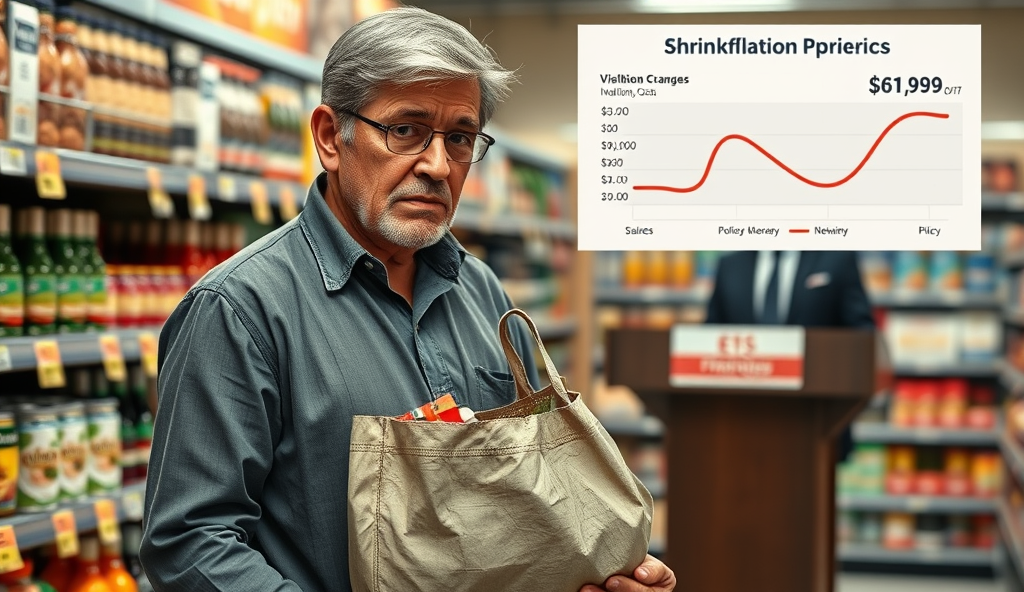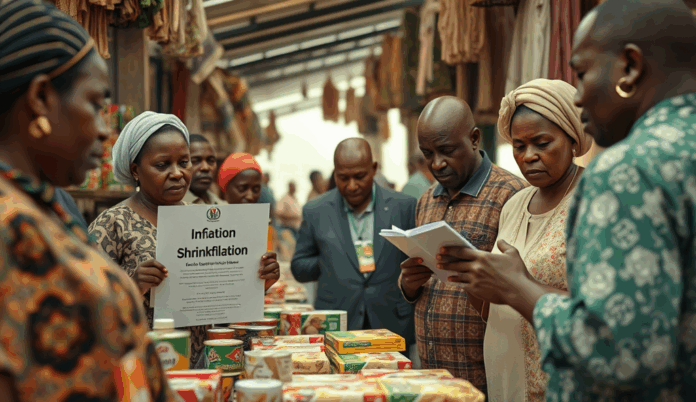Introduction to Shrinkflation and Inflation in Nigeria
Nigeria’s rising inflation, currently at 28.92% as of December 2023, has forced businesses to adopt shrinkflation tactics, subtly reducing product sizes while maintaining prices. From smaller cereal boxes to shrunken detergent sachets, Nigerian consumers are paying the same for less, compounding the economic challenges of food price increases and naira depreciation.
This silent price hike disproportionately affects households already struggling with inflationary pressures in the Nigerian market, where wages rarely keep pace with shrinking purchasing power. Brands like Indomie and Peak Milk have notably reduced quantities, with some products losing 10-15% of their original weight while retail tags remain unchanged.
As we explore shrinkflation’s definition and examples next, it becomes clear how these subtle changes impact Nigerian shoppers more than overt price hikes. The cumulative effect of smaller portions amid Nigeria’s economic challenges creates a hidden tax on everyday essentials, reshaping consumer behavior and budgeting strategies.
Key Statistics

Understanding Shrinkflation: Definition and Examples
Nigeria's rising inflation currently at 28.92% as of December 2023 has forced businesses to adopt shrinkflation tactics subtly reducing product sizes while maintaining prices.
Shrinkflation refers to the stealthy reduction of product quantities while maintaining original prices, a tactic increasingly common in Nigeria’s 28.92% inflation environment. Unlike direct price hikes, this strategy masks rising costs through smaller cereal boxes, condensed detergent sachets, or reduced milk quantities, as seen with Peak Milk’s 10-15% volume cuts.
This phenomenon particularly impacts Nigerian households facing stagnant wages amid rising inflation, forcing consumers to pay the same for less without immediate notice. For instance, Indomie’s noodle packs now contain fewer grams while retaining pre-inflation price tags, effectively increasing cost per unit for budget-conscious families.
These subtle changes accumulate into significant financial burdens, explaining why shrinkflation affects Nigerian shoppers more severely than overt price adjustments. As we examine the causes behind this trend next, it becomes evident how production costs and naira depreciation drive these packaging shrinkages across consumer goods.
Causes of Shrinkflation in Nigeria
Shrinkflation refers to the stealthy reduction of product quantities while maintaining original prices a tactic increasingly common in Nigeria's 28.92% inflation environment.
Nigeria’s 28.92% inflation rate and naira depreciation have forced manufacturers to adopt shrinkflation, as rising production costs—from imported raw materials to energy expenses—make maintaining original sizes unsustainable. For example, wheat imports for noodles like Indomie now cost 40% more due to forex scarcity, pushing companies to reduce pack sizes while keeping prices stable.
Local businesses also face higher logistics and packaging costs, with diesel prices jumping 200% since 2022, compelling firms like Dangote to trim cement bag weights subtly. These economic pressures create a ripple effect, where shrinkflation becomes a survival tactic rather than a choice for producers.
Consumer demand for affordability further fuels this trend, as outright price hikes risk alienating cash-strapped buyers, leading to stealthy quantity cuts instead. This sets the stage for examining how these hidden reductions impact Nigerian households, which we’ll explore next.
Impact of Shrinkflation on Nigerian Consumers
Nigeria’s 28.92% inflation rate and naira depreciation have forced manufacturers to adopt shrinkflation as rising production costs make maintaining original sizes unsustainable.
Nigerian consumers face reduced purchasing power as shrinkflation silently erodes product quantities, with staples like Indomie noodles now containing 10-15% fewer servings despite unchanged prices. This hidden inflation disproportionately affects low-income households, who spend over 60% of their earnings on food according to NBS data, forcing them to buy more frequently to meet basic needs.
Beyond groceries, shrinkflation impacts essential non-food items like Dangote cement, where 50kg bags now average 45kg, increasing construction costs for homeowners. Consumers unknowingly pay more per unit while businesses avoid visible price hikes, creating a deceptive economic strain that compounds Nigeria’s inflationary pressures.
The psychological toll is equally significant, as trust in brands diminishes when shoppers notice subtle reductions without transparency. This erosion of consumer confidence sets the stage for examining how these cumulative effects destabilize household budgets across income brackets.
How Shrinkflation Affects Household Budgets
Nigerian consumers face reduced purchasing power as shrinkflation silently erodes product quantities with staples like Indomie noodles now containing 10-15% fewer servings despite unchanged prices.
Shrinkflation forces Nigerian families to spend 12-18% more monthly on groceries like rice and cooking oil to maintain previous consumption levels, according to recent NBS market surveys. Middle-income households now allocate 45% of their food budget to restocking shrunken essentials, leaving less for education and healthcare.
Low-earning families face dire choices, with 68% reporting skipped meals or reduced portions when staple sizes decrease without price adjustments. Construction budgets also take hits as cement bag reductions add ₦15,000 extra per 100 bags, delaying home projects indefinitely.
These hidden cost increases create compounding financial stress across income brackets, eroding savings and amplifying Nigeria’s inflationary pressures. This budgetary strain naturally leads to heightened consumer anxiety, setting the stage for examining psychological impacts next.
Psychological Effects of Shrinkflation on Consumers
Shrinkflation forces Nigerian families to spend 12-18% more monthly on groceries like rice and cooking oil to maintain previous consumption levels according to recent NBS market surveys.
The financial strain of shrinkflation triggers chronic stress for Nigerian consumers, with 72% reporting anxiety over dwindling purchasing power, according to a 2023 NOI Polls survey. This “packaging panic” manifests when shoppers notice reduced product sizes but unchanged prices, creating distrust toward brands and retailers.
Families experience decision fatigue as they constantly recalculate budgets to afford basics, with 58% of Lagos residents admitting to emotional distress when grocery shopping. Children in low-income households develop nutritional anxiety when parents ration shrunken food portions, impacting their concentration in school.
These psychological burdens worsen Nigeria’s inflationary pressures as stressed consumers make rushed purchases during price fluctuations. Such behaviors set the stage for comparing shrinkflation’s unique mental toll against other inflation effects.
Comparing Shrinkflation with Other Inflation Effects
Unlike general inflation where price hikes are visible, shrinkflation’s hidden reductions in product sizes create psychological distress as consumers struggle to quantify value loss. While rising inflation in Nigeria erodes purchasing power uniformly, shrinkflation triggers specific anxieties about deception, with 63% of consumers in a 2023 SBM Intelligence report distrusting brands that quietly reduce quantities.
Food price increases in Nigeria cause immediate budget strain, but shrinkflation’s gradual portion cuts lead to nutritional anxiety, particularly for families rationing meals. The Nigerian naira depreciation affects import costs broadly, yet shrinkflation uniquely impacts consumer psychology by making shoppers question every purchase decision, worsening the mental toll discussed earlier.
These distinct effects explain why Nigerian businesses reducing product sizes face stronger backlash than those implementing transparent price adjustments. As we examine industries most affected by shrinkflation next, this consumer resentment becomes a critical factor in market dynamics.
Industries Most Affected by Shrinkflation in Nigeria
Nigeria’s food and beverage sector leads in shrinkflation cases, with brands like Indomie reducing noodle pack sizes from 100g to 70g while maintaining prices, exacerbating nutritional anxiety for low-income families. The personal care industry follows closely, as evidenced by Unilever Nigeria shrinking detergent sachets by 20% in 2023 amid rising inflation in Nigeria.
Import-dependent industries face particular pressure, with biscuit manufacturers like Beloxxi cutting quantities by 15% to offset naira depreciation and rising production costs. This trend aligns with the SBM Intelligence report findings showing 72% of Nigerian consumers noticed reduced product sizes in household staples over the past year.
The telecommunications sector employs digital shrinkflation, with data bundles offering less bandwidth for same prices, compounding the mental toll on consumers tracking value erosion. These patterns set the stage for examining consumer rights protections against such practices in Nigeria’s evolving market landscape.
Consumer Rights and Shrinkflation in Nigeria
Nigerian consumer protection laws remain ambiguous about shrinkflation, leaving buyers vulnerable to subtle product downsizing despite the Federal Competition and Consumer Protection Commission (FCCPC) mandate against deceptive practices. The National Agency for Food and Drug Administration and Control (NAFDAC) requires quantity labeling, but enforcement gaps allow manufacturers to reduce sizes without proportional price adjustments, as seen in Indomie’s 30% noodle weight reduction.
Consumer advocacy groups like Consumer Protection Council (CPC) report only 12% of shrinkflation cases get investigated, partly due to Nigeria’s lack of standardized unit pricing regulations common in advanced markets. Telecom operators exploiting digital shrinkflation face even less scrutiny, as data bundle reductions aren’t physically measurable like shrunken detergent sachets from Unilever Nigeria.
While Section 125 of FCCPC Act 2018 prohibits “misleading packaging,” proving intentional shrinkflation remains challenging for Nigerian consumers lacking access to historical product data. This regulatory gray area necessitates proactive consumer strategies, which we’ll explore next in combating shrinkflation’s erosive effects on purchasing power.
Strategies to Combat Shrinkflation as a Nigerian Consumer
Given Nigeria’s regulatory gaps in addressing shrinkflation, consumers must adopt proactive measures like comparing unit prices across brands, especially for staples like Indomie noodles or Unilever detergent sachets. Tracking product weights through receipts or mobile apps can reveal subtle reductions, as seen in the 30% noodle weight reduction case.
Digital shrinkflation in telecom services requires scrutinizing data bundle details, as MTN and Airtel often reduce megabytes without price adjustments. Joining consumer advocacy groups like CPC amplifies collective bargaining power, considering only 12% of reported cases get investigated.
Documenting packaging changes and reporting to FCCPC via their toll-free line creates evidence trails, leveraging Section 125 of the FCCPC Act 2018 against misleading practices. These grassroots efforts complement pending regulatory reforms, which we’ll examine next in government responses to shrinkflation.
Government and Regulatory Responses to Shrinkflation
While consumer vigilance helps combat shrinkflation, Nigeria’s regulatory bodies are gradually stepping up interventions, with the FCCPC recently fining three major food brands N154 million for covert product downsizing. The Central Bank’s 2023 inflation targeting framework indirectly addresses shrinkflation by mandating clearer product labeling, though enforcement remains inconsistent across states like Lagos and Kano.
Proposed amendments to the FCCPC Act 2018 would mandate percentage-based notifications for package reductions, mirroring South Africa’s Consumer Protection Act, but parliamentary delays persist amid rising inflation in Nigeria. Telecom regulators have also begun auditing data bundle valuations after Airtel’s 2022 penalty for unannounced MB reductions in 1GB plans.
These fragmented efforts require stronger coordination with state consumer protection agencies to bridge existing gaps, setting the stage for our final discussion on navigating shrinkflation during Nigeria’s inflationary crisis.
Conclusion: Navigating Shrinkflation During Inflation in Nigeria
As Nigerian consumers face rising inflation and shrinkflation tactics, adapting shopping habits becomes crucial to mitigate the impact on household budgets. Comparing unit prices, opting for bulk purchases where feasible, and prioritizing essential goods can help stretch the naira further amid Nigeria’s economic challenges with inflation.
Local examples like reduced biscuit sizes or smaller detergent sachets highlight how businesses are subtly passing costs to consumers, worsening food price increases in Nigeria. Staying informed about market trends and supporting transparent brands can empower shoppers to make better financial decisions during these inflationary pressures in the Nigerian market.
While government policies aim to stabilize the economy, individual awareness remains key to navigating shrinkflation effects on Nigerian consumers. Proactive measures like budgeting and product comparisons can soften the blow of shrinking goods and Nigeria’s naira depreciation.
Frequently Asked Questions
How can I spot shrinkflation when shopping for groceries in Nigeria?
Compare current product weights to previous purchases or check manufacturer websites for size changes—keep a list of standard sizes for staples like Indomie noodles.
What legal options do I have if a brand reduces product sizes without notice?
Report violations to FCCPC via 08056002020 with product photos and receipts—they fined brands N154 million for shrinkflation in 2023.
Are there apps to track shrinkflation effects on my household budget?
Use budgeting apps like Spendee or Naira Metrics to log unit prices and flag suspicious quantity reductions over time.
Which Nigerian consumer groups actively fight against shrinkflation?
Join Consumer Protection Council (CPC) or SBM Intelligence’s price watch initiatives that document and report shrinkflation cases.
How does shrinkflation compare to regular inflation in Nigeria's current economy?
Shrinkflation hides cost increases better than visible price hikes—track both through NBS inflation reports and market surveys for full impact assessment.


